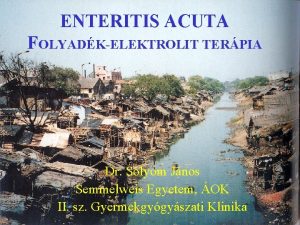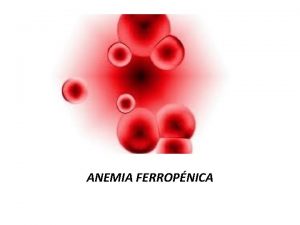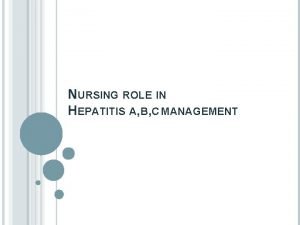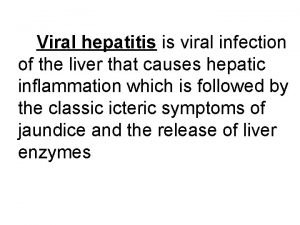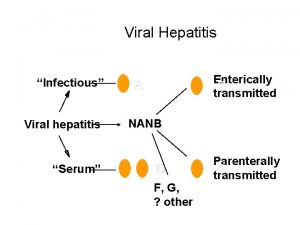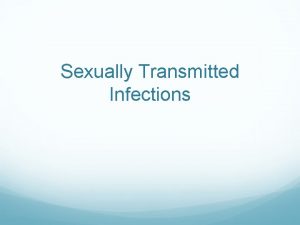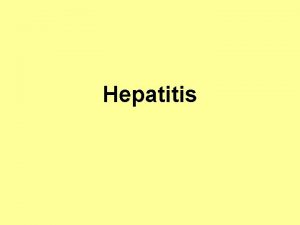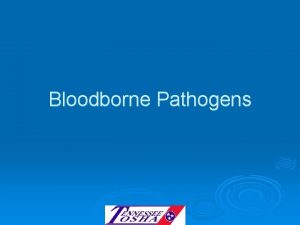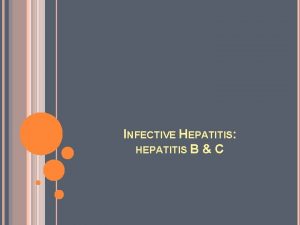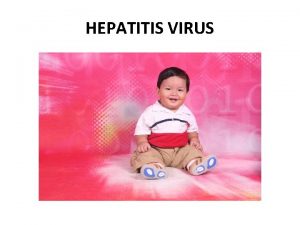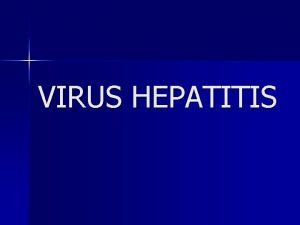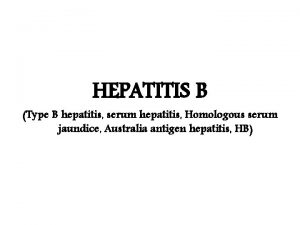Enteritis and Hepatitis in dog and Cats VCM














- Slides: 14

Enteritis and Hepatitis in dog and Cats (VCM -604) Part-1 Dr. Pallav Shekhar Asstt. Prof Veterinary Medicine, BVC

ENTERITIS (ENTEROPATHY, MALABSORPTION SYNDROME) Ø Definition: Enteritis is an inflammation of the small intestine and is caused by Parasites, bacteria, viruses, or allergies. All these etiological agents can inflame the small intestines of dog, leading to diarrhea as the principal clinical manifestation. Ø Some time enteritis is associated gastritis and is called gastroenteritis. 2

Etiology I- Predisposing factors 1. Factors lower the animal immunity, thus increasing the pathogenicity of the causative agent to induce enteritis: 2. The newly born animals are deficient in immunoglobulins are more susceptible than adults. 3. Stress of transportation. 4. Stress of deprivation of food and water. 5. Stress of weaning. 6. Prolonged use of antibacterial agents orally may alter the intestinal microflora and permit the development of superinfection by organisms which would not normally cause disease. 3

Etiology • Bacterial: E. coli, Salmonella typhimurium and S. Dublin, Clostridium perfringens type A, B, C and E, Campylobacter jejuni and Yersinia enterocolitica. • Viral: Canine Corona Virus, Canine Parvo virus and ICH, Rota virus, Paramyxovirus • Parasitic: Ancylostoma caninum, Toxocara canis, Dipylidium caninum and Toxocara leolina

Pathogenesis Etiological factors Inflammation Necrosis MM bacteria and virus multiply in the brush border cells decreased carrier-protein function Secretion-absorption defect colibacillosis the intestinal secretion is increased beyond the absorptive capacity Osmotic disturbance overfeeding and indigestible feeds malabsorbed nutrients exert strong intraluminal osmotic effects movement of excessive increase in the cyclic decreased mucosal absorptive adenosine monophosphate amount of fluid into the surface area lumen of intestine Loss of Na, cl, HCO 3 and Decrease transport of nutrients watery feces and diarrhea Into circulation Metabolic acidosis dehydration 5

Osmotic diarrhoea: Saline purgatives, Over feeding, Indigestible feeds and disaccharide deficiency Inflammatory or necrotic diarrhoea: Found in acute and chronic inflammation and necrosis of intestinal mucosa. There is net increase in fluid production and inflammatory products including serum protein. There is reduction in absorption. This is found in bacterial, viral, protozoal and chemical agents. Secretary absorptive defects diarrhoea: Large net increase in fluid secretion with little change in mucosal cells. Eg. Enterotoxigenic E. coli

Clinical findings • • Diarrhoea Dehydration Weight loss Fever Circulatory collapse Uremia Acidosis Abdominal pin

Clinical findings Diarrhea/Dysentery: – Watery diarrhoea – Watery and profuse. -Samll intestinal – Small volume with excess quantity of mucus-Large intestinal. – With blood- Severe inflammation – Voluminous, soft and odoriferous. 8

Dehydration – Dry muzzle, sunken eye, shrunk skin and oliguria. – Dehydration can be assessed by tainting of the skin. 9

Weight loss • Usually associated with chronic diarrhea • Protein losing enteropathy. Systemic reaction • Septicemia, toxemia and fever occur mostly in infectious enteritis, such as salmonellosis and colibacillosis 10

Peripheral circulatory collapse • Due to dehydration there is uremia, anuria and hypovolemic shock. Acid-base and electrolyte imbalance • Loss of bicarbonate. • Hyponatremia 11

Diagnosis • • • History Clinical signs Lab. Diagnosis: Faecal serology, faecal culture, Radiographic examination nd diagnosis of exocrine pancreatic insufficiency. 12

Treatment • • • Diet Causative agents Fluids and electrolytes. Intestinal protectants and adsorbents. Use of anti-diarrheal drugs. 13

THANK YOU
 Enteritis acuta
Enteritis acuta Anemia megaloblastica
Anemia megaloblastica Anemias megaloblasticas
Anemias megaloblasticas Indice de reticulocitos
Indice de reticulocitos Vcm 0833
Vcm 0833 Complement pronouns
Complement pronouns Hepatitis c
Hepatitis c Hepatitis b markers interpretation
Hepatitis b markers interpretation Hepatitis e
Hepatitis e Window period of hepatitis b
Window period of hepatitis b Symptoms of gonorrhea
Symptoms of gonorrhea What stds are cureable
What stds are cureable Dosis de hepatitis b
Dosis de hepatitis b Hepatitis alimentos permitidos y no permitidos
Hepatitis alimentos permitidos y no permitidos Hepatitis causes
Hepatitis causes
